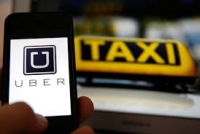Uber Rulling Goes Under the Legal Microscope
Thursday 03 November, 2016 Written by Simon Quantrill
The Uber Case has attracted a lot of attention. In the ‘Gig Economy' many workers are not sure what their rights and obligations are in law.
This insightful article from leading employment law expert Simon Quantrill of Quantrills Employment Law Solicitors explains the Uber case in detail.
+++
Last week the employment tribunal found that two taxi drivers were "workers” driving for Uber, the smartphone app based ‘taxi’ service. The claimants are now entitled to protection under the Working Time Regulations, including 5.6 weeks’ paid annual leave, a maximum 48 hour working week, the National Minimum Wage and protection against suffering a detriment if they whistle blow.
Given the world wide interest in Uber’s business model and phenomenal growth (there are about 30,000 Uber drivers operating in London alone with over two million registered passengers) it’s not surprising that over the past few days there has been considerable media interest although most has misunderstood the case and its result!
The background to this case is that a group of 19 current and former Uber drivers brought claims in the employment tribunal based on being “workers” within the meaning of the Employment Rights Act 1996. It was never their case that they were employees. Two of the 19 cases were adopted as test cases.
What does “worker” mean?
Under section 230 of the Employment Rights Act 1996 a worker is defined as including an individual who works (a) under a contract of employment or (b) any other contract where he or she provides personally any work or services to another party to the contract whose “status is not by virtue of the contract that of a client or customer of any profession or business undertaking carried on by the individual.”
The drivers claimed they fell under (b).
This case was not about the genuinely self-employed tradesman or professional who fall outside the definition of “worker”. For this group of self-employed nothing has changed. But for those individuals who work in what the employment tribunal described as the “the field of dependant work relationships” who are disadvantaged because of an imbalance of bargaining power - as here between the low paid taxi drivers and a large global “transportation” company - this case has shown (again) how the current employment law operates to protect this group of workers. In fact it was exactly this type of disadvantaged workers that the definition of “worker” under the Employment Rights Act 1996 was introduced to give some extra protection to help redress the imbalance arising from their subordinate and dependant position with their ‘employers’.
When deciding this case the tribunal had to answer the key question; what was the true contractual agreement between the parties?
The tribunal held that Uber’s contractual relationship with the drivers was not “arm’s length between two independent business undertakings” which has to be the case for genuine self-employed relationships. Instead the tribunal held that the drivers were “recruited” to work as an integral part of Uber’s business model and this made them workers with increased rights and protections.
No new law has been made by this Uber decision. Instead the employment tribunal looked critically at the facts and was able to easily conclude that the drivers were workers because they had to provide personal service, with no right to provide a substitute and on a true analysis of Uber’s UK business model they were not self-employed.

Image: Simon Quantrill
So why did Uber lose the arguments?
The claimants argued, given the restrictions imposed on them by Uber, that they were workers being denied their statutory rights to holiday pay and the national minimum wage. Uber’s response was it was a software company that hired out its app to taxi drivers in return for 25% of each fare and it was not in the business of providing ‘transportation services’. Uber said it was working for the drivers instead of the drivers working for it.
The employment tribunal concluded the following:
- Uber had gone to “remarkable lengths” to impose contractual terms and conditions on the drivers and passengers that were fictitious and falsely sought to avoid the basic fact that Uber was in business of “running an enterprise at the heart of which was the function of carrying people in motor cars from where they are to where they want to be.” The tribunal said Uber “resorted in its documentation to fictions, twisted language and even brand new terminology.” (You can see how the tribunal was far from impressed by how Uber presented its evidence and arguments.)
- For example, after the passenger had paid and been dropped off, Uber’s app produced an ‘invoice’ but this was not given to the passenger, it did not even show the passenger’s name. It was just a fiction to help create the illusion that there was a contract between the driver and the passenger. The tribunal said there could not be because the driver never knew the passenger’s name nor the destination until he had agreed to pick the passenger up. The driver was told where and when to collect the passenger and Uber told him how much to charge for the fare and even which route to take.
- The use of “twisted language” is illustrated by Uber’s contractual terms that described each driver as “an independent company in business of providing Transportation Services”. Uber also had to argue that there was no contractual relationship between it and the drivers, but if there was Uber asserted that it was a “Customer” of the drivers! The tribunal disagreed.
- The tribunal found that the drivers had to apply and then be interviewed before being allowed to become Uber drivers. To camouflage this requirement, Uber described its recruitment steps as “on-boarding” an expression the tribunal had no time for.
- Uber had tried (with the help of its army of lawyers) to hide the true contractual and factual reality of its business model. Uber’s main witness was a regional manager. The tribunal said her “grimly loyal” evidence made them conclude, quoting from Hamlet, “The lady doth protest too much, methinks”. Clearly the tribunal afforded little or no creditability to this witness.
- Uber also skidded off the road so to speak, because the tribunal concluded there were many occasions when it said and wrote “in unguarded moments” things that supported “the claimants’ simple case that the organisation runs a transportation business and employs the drivers to that end.” For example, in marketing promotions, Uber used the term “Uber drivers” and “our drivers” and “Uber [having] more and more passengers”. Such comments were entirely at odds with Uber’s case that it was not operating as a taxi provider. Uber’s case was not helped when, on Twitter, it said “We’re a transportation network”.
- Uber’s key witness did not help matters by the tribunal concluding that “we are not all persuaded by Ms Bertram’s ambitious attempts to dismiss [the above marketing examples] as mere sloppiness of language.”
- The tribunal held that it was “unreal to deny that Uber is in business as a supplier of transportation services.” It said that “simple common sense argues to the contrary” pointing for example to Uber’s promoted “product range” and its marketing that is “self-evidently not done for the benefit of any individual driver. Equally self-evidently, it is done to promote Uber’s name and ‘sell’ its transportation services.”
- The tribunal said it was “faintly ridiculous” for Uber to contend that in London it was a “mosaic of 30,000 small businesses linked by a common ‘platform’.” In each case, the ‘business’ consists of a man with a car seeking to make a living by driving it.
- The tribunal disagreed that Uber was in the business of supplying “leads” for the drivers. The tribunal said this suggests “that the driver is put into contact with a possible passenger with whom he has the opportunity to negotiate and strike a bargain. But drivers do not and cannot negotiate with passengers . . . they are offered and accept trips strictly on Uber’s terms.”
- Notwithstanding Uber’s best efforts to argue otherwise, the tribunal said the only “sensible interpretation” is that Uber runs a transportation business with the drivers providing the skilled labour through which the service is provided and it earns its profits. This conclusion was based on the true contractual relationship between Uber and the drivers; for example, Uber controls all the information for each passenger and trip, the drivers have to accept the trips and must not cancel trips or they will suffer a penalty. Drivers must not depart from the route dictated by the Uber app. Uber picks up the cost for refunds and often without any consultation with the drivers. Uber imposes a performance management system on the drivers that has at its heart a rating system. Uber handles customer complaints and lost property. Each of these examples clearly pointed the tribunal towards its conclusion that Uber was trying to hide its true status.
- The tribunal concluded that “the drivers are recruited and retained by Uber” who then provide their driving services in return for the fare. No amount of “carefully crafted documentation” by Uber’s lawyers hid the true reality of the contractual relationship between Uber and its drivers. Given that the contractual documentation does not reflect the reality of the relationship the tribunal was “free to disregard” it. Much of Uber’s documentation was too legalistic and written “in impenetrable prose” which meant that most drivers would not have been able to understand it even if they could have read it.
What happens now?
There is little doubt Uber must be looking at appealing (and we understand has already indicated its intention to), but looking at the findings of fact and the well written 40 page judgment I think Uber may well struggle to appeal successfully. Interestingly the tribunal made the point that Uber “could” have devised a business model not involving them employing drivers but concluded “we find only that the model which they chose fails to achieve that aim.”
As it stands, however, contrary to Uber's attempts to play down the decision, it will apply to all Uber drivers and will be relied on by the trade unions to advance claims for many other “self-employed” people.
You can contact Quantrills Employment Law Solicitors by clicking here:
Article reproduced courtesy of: Quantrills Employment Law Solicitors.
1 comment
-
Comment Link
 Thursday 03 November, 2016
posted by
Simon Collyer
Thursday 03 November, 2016
posted by
Simon Collyer
Leave a comment
Make sure you enter all the required information, indicated by an asterisk (*). HTML code is not allowed.
Join
FREE
Here











